![]()
SAILING TO JAMBŪDVĪPA
The Vedic History Reveals a Greater Earth Plane — Part Two
BY: MAYESVARA DASA
Mar 27, 2018 — IRELAND (SUN) —
King Yudhisthira in Jambudvipa
Part one of this paper can be found here.
In this paper we will be looking at the Srimad Bhagavatam's description of the shape and size of the Earth, particularly in relation to the history of Yudhisthira's rule over Jambudvipa (the central island of a greater Earth plane) that is measured at 100,000 yojanas (800,000 miles). The history of the Pandavas governing such a vast measurement of Earth is in obvious conflict with the idea that the Earth is a small globe-shaped planet that floats in space.
The history of Yudhisthira raises important questions for members of the International Society for Krishna Consciousness who have the responsibility for depicting and explaining the Vedic conception of the Earth at the up and coming Temple of Vedic Planetarium (TOVP) in Mayapur India. We hope that the historical accounts describing events on a greater Earth plane will stimulate a change in consciousness in regards to our current understanding of the Earth.
Surprisingly, in the Vedic cosmos, the Earth (Bhu-mandala) is actually described as being the largest feature in the universe, taking the form of a vast circular disc that spans the center of the universe: The strategic importance of this great Earth plane is explained by Sanjaya in the following way:
"Sanjaya: Everything springeth from the Earth and everything, when destroyed, mergeth into the Earth. The Earth is the stay and refuge of all creatures, and the Earth is eternal. He that hath the Earth, hath the entire universe with its mobile and immobile population. It is for this that longing for (the possession of the) Earth, kings slay one another.'" (Mahabharata, Bhisma Parva, Section IV)
The necessity to maintain dharma on the Earth is imperative not only for the welfare of all who live on the Earth, but also for the welfare of the whole universe. The Srimad Bhagavatamdescribes that 5,000 years ago, many demons in the disguise of human kings had appeared on the Earth (Bhu-mandala) and were creating great disturbance. Thus Bhumi (the personified Earth) appealed to Brahma, and on Brahma's appeal, Lord Krishna eventually incarnated with His eternal associates like Yudhisthira, Bhima, Arjuna, Nakula and Sahadeva (the Pandavas), in order to halt the advance of the demons who had become a burden on the Earth (bhu-bhara).
The following verse describes Yudhisthira's eventual sovereignty over the Earth after the demoniac armies had been defeated:
"Thus, when he [Vidura] was in the land of Bharatavarsha traveling to all the places of pilgrimage, he visited Prabhasakshetra. At that time Maharaja Yudhisthira was the emperor and held the world under one military strength and one flag." (Srimad Bhagavatam 3.1.20)
In the above verse we hear that Maharaja Yudhisthira ruled the world (chasasa kshitim) with one military force and under one flag. Here the word used for the Earth is kshitim. But what (according to Srimad Bhagavatam) is the size and nature of the Earth that Yudhisthira ruled over? Srimad Bhagavatam specifically states that Maharaja Yudhisthira's sovereignty was over the whole of Jambudvipa which is in the very center of the Earth:
sampadah kratavo loka mahishi bhrataro mahi
jambudvipadhipatyam ca yasas ca tri-divam gatam
"News even reached the celestial planets about Maharaja Yudhishthira's worldly possessions, the sacrifices by which he would attain a better destination, his queen, his stalwart brothers, his extensive land, his sovereignty over the planet earth, and his fame, etc." (Srimad Bhagavatam 1.12.5)
In the above verse the Sanskrit words for Yudhisthira's sovereignty over Jambudvipa is clearly mentioned: jambudvipadhipatyam. Srila Prabhupada translates the above verse jambudvipadhipatyam as Yudhisthira's 'sovereignty over the planet Earth.' Without getting specific about Jambudvipa, Srila Prabhupada appears to be simply giving us some bearings in the Vedic universe - Jambudvipa is the central island of the Earth which Srila Prabhupada simplifies as 'the planet Earth.' However, unless one is aware of the original description of Jambudvipa, the reader may simply gloss over the translation without realizing the implications of this verse to our current understanding of the Earth. Sukadeva Goswami's description of the Earth covers ten chapters of the fifth canto starting at chapter 16, which is entitled 'A Description of Jambuvipa'. Here the central and most important island of the Earth (Jambudvipa) is described to be circular with a diameter 100,000 yojanas (800,000 miles).
Thus, the world of Maharaja Yudhisthira refers to the entire Jambudvipa, not just the few continents that we know as Earth. During the last few centuries, the material energy (maya) has presented the idea that we live on an Earth globe floating in space. Thus we are made to feel that one simply goes around an Earth globe and that all areas of this globe have been mapped and explored. So-called images of the Earth globe from outer-space have instilled this construct of reality into people's minds. The record of the Earth's history contained in the Puranas which describes superhuman beings governing a greater Earth plane is now simply dismissed as mythological. Due to this current model of the Earth, even followers of Vedic literature have lost sense of what it means when they read about the Pandavas pastimes in Jambudvipa. For example, most members of ISKCON will have read Krishna Dharma dasa's excellent and popular rendition of Mahabharata, but perhaps without understanding the significance of certain place names that are associated with Jambudvipa. In part two, chapter thirty we read:
"…the brothers continued their journey, seeing in the distance the cloud-covered peak of Mount Himavat. Eventually passing that great mountain, they crossed over a desert and came at last to Mount Meru where lay the abode of the gods. As they made their way through the hilly region, they were joined by a dog, who stayed with them day and night. Soon they reached the foothills of Gandhamadana Mountain, where they had spent much of their exile. They bowed down and offered prayers to the sacred mountain, then began their ascent." (Krishna Dharma dasa, Mahabharata, Part Two, Chapter 35, The Pandavas Retire)
Here we read that the Pandavas crossed the Himavat (Himalaya) and came to Mount Meru and Gandhamadana. So where are these three mountains (Himavat, Meru, and Gandhamadana) that are mentioned in Mahabharata and Srimad Bhagavatam? Are they features on this so-called Earth globe, or are they features on a greater Earth plane?
According to Srimad Bhagavatam, Mount Meru is at the very center of the Earth and is several hundred thousand miles from where we are in Bharata-varsha. Srimad Bhagavatamdescribes the Himavat as 80,000 miles high and 16,000 miles wide. Further calculations reveal its length to be 480,000 miles across. The Himavat is one of three such mountains to the south of Mount Meru which is in Ilavrita-varsha:
"Similarly, south of Ilavrita-varsha and extending from east to west are three great mountains named (from north to south) Nishadha, Hemakuta and Himalaya. Each of them is 10,000 yojanas [80,000 miles] high. They mark the boundaries of the three varshas named Hari-varsha, Kimpurusha-varsha and Bharata-varsha [India]." (SB 5.16.8)
Perhaps to give us some bearings in the Vedic universe, Srila Prabhupada sometimes identifies Bharata-varsha as India, whilst in other places Srila Prabhupada identifies Bharata-varsha as our entire Earth. However, when we look at the measurements given, it appears that Bharata-varsha includes an even greater area of the Earth plane described in Srimad Bhagavatam. For example, the Himavata/Himalaya mentioned in the above verse is 80,000 miles high and 16,000 miles across. The Himavata forms the northern border of Bharata-varsha, after which one comes to the other varshas of Jambudvipa. As mentioned in the Mahabharata, the Pandavas were able to cross these huge mountains and eventually make their way to Mount Meru, which is at the center of Jambudvipa and stands at 800,000 miles in height. Gandhamadana Mountain is also mentioned here and its position is shown in the diagram below:
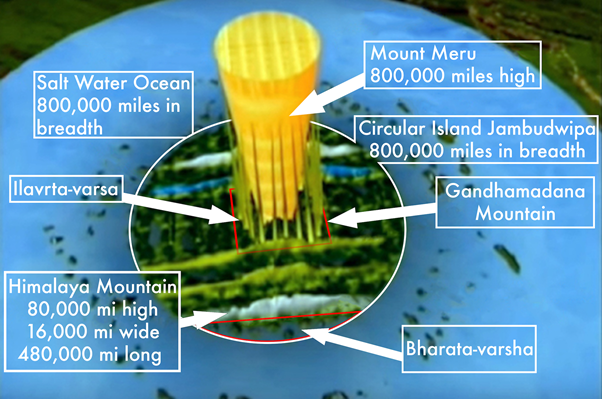
Vayu Purana describes Gandhamadana as follows:
"…to the west of Meru lies the mountain Gandhamadana, thirty-four thousand yojanas long (272,000 miles). To the north and south, it stretches up to Nila and Nisadha Mountains." (Vayu Purana, Chapter 46, verses 18-19, translated by GV Taga
In the aerial image below of Jambudipa we can see more clearly the location of Gandhamadana Mountain running north to south between the Nila and Nishada Mountain ranges:
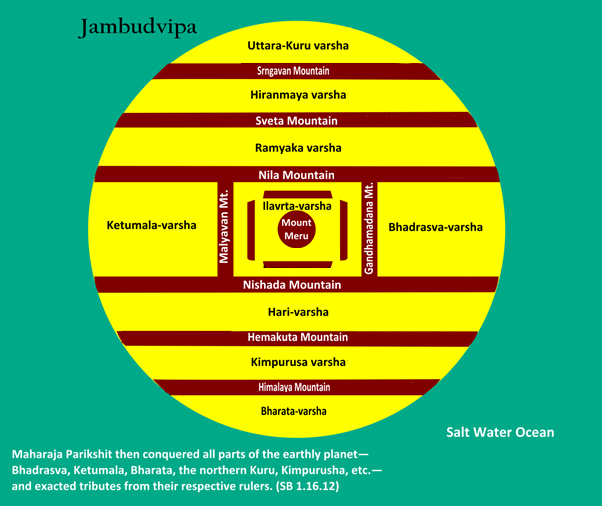
Srimad Bhagavatam places Gandhamadana to the East of Meru (SB 5.16.10), but otherwise the description with Vayu Purana is the same. Here the great length of Gandhamadana of 272,000 miles informs us that the Pandavas were traversing a landscape that goes way beyond our known Earth.
In Kisari Mohan Ganguli's complete English translation of Mahabharata we get a more detailed description of the Pandavas conquest of areas in Jambudvipa on behalf of their brother Yudhisthira. For example, we hear of Arjuna conquering Kimpurusha-varsha and taking tribute from the residents of Hari-varsha. These varshas are to the north of Bharata-varsha and cover an area of hundreds of thousands of miles:
"Vaisampayana said, "That heroic and foremost of the Pandavas endued with great energy, crossing the White mountains, subjugated the country of the Kimpurushas ruled by Durmaputra, after a collision involving a great slaughter of Kshatriyas, and brought the region under his complete sway…At last the son of the slayer of Paka, arriving in the country of the North Harivarsha desired to conquer it. Thereupon certain frontier guards of huge bodies and endued with great strength and energy coming to him with gallant hearts said, 'O son of Prita, this country can never be conquered by thee. If thou sleekest thou good, return hence. He that entereth this region, if human is sure to perish. We have been gratified by thee; O hero thy conquests have been enough. Nor is anything to be seen here, O Arjuna that can be conquered by thee. The Northern Kurus live here. There cannot be war here. Even if thou enterest it, thou will not be able to behold anything for with human eyes nothing can be seen."(Mahabharata, Sabha Parva, Section XXVII)
In the above text there seems to be some type of conflation of Hari-varsha, and Uttara-kuru-varsha which is the northernmost varsha of Jambudvipa. Nonetheless, it mentions Kimpurusha-varsha and Hari-Varsha, and giant guards from Uttara-kuru varsha. As one goes north from Bharata-varsha towards the mainland of Jambudvipa, one has to first cross the great Mountain called Himavat or Himalaya. As already mentioned, this mountain is 80,000 miles, 480,000 miles across and 16,000 miles wide. Srila Prabhupada also mentions how Arjuna conquered these areas in a purport to Srimad Bhagavatam 1.16.12:
"Kimpurusha-varsha: It is stated to be situated north of the great Himalaya Mountain, which is eighty thousand miles in length and height and which covers sixteen thousand miles in width. These parts of the world were also conquered by Arjuna (Sabha 28.1-2)." (SB 1.16.12 purport)
The illustration below from Danavir Gowami's Vedic Cosmos shows the relation of Bharata-varsha to the great Himalayan Mountain that forms a border between Bharata-varsha and the other varsha's of Jambudvipa. Our own area of the Earth would be situated somewhere in Bharata-varsha surrounded by the salt-water ocean (our salt-water oceans are just a minuscule drop of the complete 800,000 mile salt water ocean that surrounds the circular island of Jambudvipa like a moat:
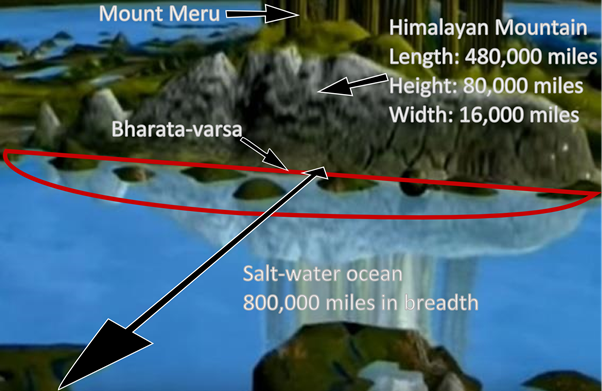
After crossing Himavat/Himalaya one then comes into Kimpurusha varsha. Like Bharata-varsha, Kimpurusa varsha is also 72,000 miles across. After crossing Kimpurusha varsha one comes to another great mountain called Hemakuta that forms a border between Kimpurusha-varsha and Hari-varsha. This mountain is again 80,000 miles high and 16,000 miles wide. We can see the different mountains and varshas in the following image:
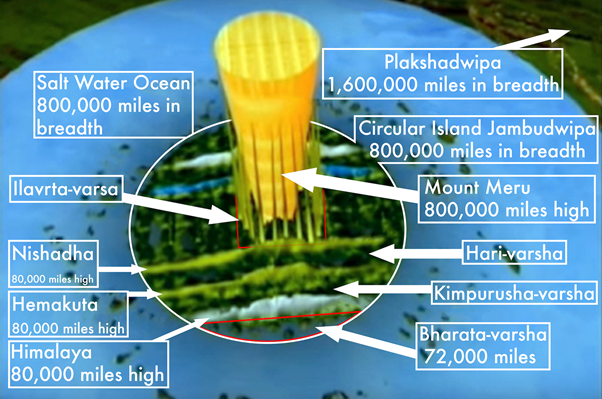
According to Mahabharata, Arjuna conquered all of these areas on behalf of his brother Yudhisthira. The above text from Mahabharata mentions that at one point Arjuna met giant guards from the Northern Kuru. Northern Kuru refers to Uttara-Kuru varsha which is at the extreme north of Jambudvipa (directly opposite Bharata-varsha). The Mahabharata text goes on to say that although Arjuna was not allowed to enter the land protected by the giant guards from Uttara-kuru, they agreed to give gifts of celestial origin to Arjuna to be presented to Yudhisthira thus acknowledging his position as Emperor over Jambudvipa:
"If, however thou seekest anything else, O Bharata tell us, O tiger among men, so that we may do thy bidding. Thus addressed by them, Arjuna smilingly addressing them, said,--'I desire the acquisition of the imperial dignity by Yudhishthira the just, of great intelligence. If your land is shut against human beings, I shall not enter it. Let something be paid unto Yudhishthira by ye as tribute. Hearing these words of Arjuna, they gave him as tribute many cloths and ornaments of celestial make, silks of celestial texture and skins of celestial origin.
"It was thus that tiger among men subjugated the countries that lay to the North, having fought numberless battles with both Kshatriya and robber tribes.
In this way Arjuna got tribute from the different varshas of Jambudvipa which are located to the north of Bharata-varsha, (areas of the Earth beyond the boundaries of our known Earth area).
It is further mentioned in Mahabharata that during Yudhisthira's Rajasuya sacrifice in which he was installed as emperor of the world, gifts were coming in from all of the different varsha's of Jambudvipa in tribute to Yudhisthira. The envious Duryodhana relates to his father King Dhritarashtra about the ocean of wealth that was pouring in from places such as Meru and Mandara Mountains, and as far away as Northern Kuru (Uttarakuru-varsha) which is on the very opposite side of Jambudvipa and hundreds of thousands of miles away from Bharata-varsha:
"Duryodhana said, 'O sinless one, listen to me as I describe that large mass of wealth consisting of various kinds of tribute presented unto Yudhishthira by the kings of the earth. They that dwell by the side of the river Sailoda flowing between the mountains of Meru and Mandara and enjoy the delicious shade of topes of the Kichaka bamboo, viz., the Khashas, Ekasanas, the Arhas, the Pradaras, the Dirghavenus, the Paradas, the Kulindas, the Tanganas, and the other Tanganas, brought as tribute heaps of gold measured in dronas (jars) and raised from underneath the earth by ants and therefore called after these creatures. The mountain tribes endued with great strength having brought as tribute numerous Chamaras (long brushes) soft and black and others white as moon-beam and sweet honey extracted from the flowers growing on the Himavat as also from the Mishali champaka and garlands of flowers brought from the region of the northern Kurus, and diverse kinds of plants from the north even from Kailasa, waited with their heads bent down at the gate of king Yudhishthira, being refused permission to enter." (Mahabharata, Sabha Parva, Section LI)
It should be mentioned that the cosmology in Mahabharata sometimes differs from the descriptions in Srimad Bhagavatam. For example, the following verse spoken by Draupadi confirms Yudhisthira's control of Jambudvipa, although the varshas of Jambudvipa seems to be mixed with the names of the other islands of Bhu-mandala:
"Formerly, O puissant one, thou hadst, O monarch, swayed with might, the region called Jambu-dwipa, O tiger among men, abounding with populous districts. Thou hadst also, O ruler of men, swayed with might that other region called Kraunchadwipa situated on the west of the great Meru and equal unto Jambu-dwipa itself. Thou hadst swayed with might, O king, that other region called Sakadwipa on the east of the great Meru and equal to Krauncha-dwipa itself. The region called Bhadraswa, on the north of the great Meru and equal to Sakadwipa was also swayed by thee, O tiger, among men! Thou hadst even penetrated the ocean and swayed with might other regions, too, O hero, and the very islands begirt by the sea and containing many populous provinces. Having, O Bharata, achieved such immeasurable feats, and having obtained (through them) the adorations of the Brahmanas, how is it that thy soul is not gratified?" (Mahabharata, Shanti-parva, XIV)
Despite there sometimes being differences among the Puranas regarding details of the size and layout of Jambudvipa, it is quite clear that all these historical texts speak of a greater Earth plane with the colossal Mount Meru situated in the center. If the Vedic history and cosmology is to be accepted as factual, then it appears that during the course of the last five thousand years of Kali-yuga we have lost contact with the other areas of the Earth described in these ancient Vedic texts. Such ideas of lost worlds are now treated as mythology. The beginning of this physical and mental separation from Jambudvipa appears to have started with the onset of Kali-yuga.
We have argued in previous papers that due to the advent of Kali-yuga 5,000 years ago, Bharata-varsha entered a kind of quarantine, and was cut off from the rest of Jambudvipa. As described in Srimad Bhagavatam 5.17.12, the other eight varshas of Jambudvipa enjoy the conditions of treta-yuga and do not appear to be subject to Kali-yuga. The other varshas of Jambudwipa are untouched by the ravages of Kali-yuga because they are meant for people enjoying the results of pious activity, and are referred to as bhaumani svarga-padani (SB 5.17.11); literally, heaven on Earth! Bharata-varsha is normally where a living entity creates karma, and the other varshas are for enjoying the results of any good karma accrued. Unlike Bharata-varsha, the other eight varshas are normally undisturbed by any inauspicious influence. As explained in the following verse from Srimad Bhagavatam:
"Among the nine varshas, the tract of land known as Bharata-varsha is understood to be the field of fruitive activities. Learned scholars and saintly persons declare the other eight varshas to be meant for very highly elevated pious persons. After returning from the heavenly planets, they enjoy the remaining results of their pious activities in these eight earthly varshas." (SB 5.17.11)
Although all these varshas are part of the same island, conditions in the other varshas of Jambudwipa are always like treta-yuga, and thus unaffected by Kali-yuga:
"In these eight varshas, or tracts of land, human beings live ten thousand years according to earthly calculations. All the inhabitants are almost like demigods. They have the bodily strength of ten thousand elephants. Indeed, their bodies are as sturdy as thunderbolts. The youthful duration of their lives is very pleasing, and both men and women enjoy sexual union with great pleasure for a long time. After years of sensual pleasure—when a balance of one year of life remains—the wife conceives a child. Thus the standard of pleasure for the residents of these heavenly regions is exactly like that of the human beings who lived during Treta-yuga." (SB 5.17.12)
The idea that the other varshas of Jambudvipa are 'heavens on Earth' begs the question of why these otherwise peaceful areas of Jambudvipa would have to be conquered by Arjuna on behalf of Yudhisthira. It seems that at this period in Earth's history (5,000 years ago), the appearance of demoniac leaders on the Earth had affected even Jambudvipa, and this was an anomaly that had to be addressed by the appearance of Krishna and His empowered associates like the Pandavas.
In any case, Vishnu Purana and other Puranas appear to distinguish Bharata-varsha from the other varshas because of the sequence of four yuga cycles, and notably the Kali-yuga:
"The country that lies north of the ocean, and south of the snowy mountains, is called Bhárata, for there dwelt the descendants of Bharata. It is nine thousand leagues in extent, and is the land of works, in consequence of which men go to heaven, or obtain emancipation…
…From this region heaven is obtained, or even, in some cases, liberation from existence; or men pass from hence into the condition of brutes, or fall into hell. Heaven, emancipation, a state in mid-air, or in the subterraneous realms, succeeds to existence here, and the world of acts is not the title of any other portion of the universe...
...In the Bharata-varsha it is that the succession of four Yugas, or ages, the Krita, the Treta, the Dwápara, and Kali, takes place." (Vishnu Purana, Book 2, Chapter 3)
Taking into consideration that the pastimes of Krishna and the Pandavas took place over the entire area of Jambudwipa, and that Kali-yuga followed the departure of the Lord, my surmise is that our area of the Earth in Bharata-varsha gradually became separated from any contact with the mainland of Jambudvipa. In this way the Kali-yuga is quarantined in Bharata-varsha, and the other varshas remain undisturbed. It thus appears that over the past five millennia, we have lost both contact and knowledge of a greater Earth area that was once ruled by Yudhisthira during the previous Dvapara-yuga. One can infer that certain psychological and physical controls prevent us from exploring beyond our known Earth area. In a conversation called 'Discussion on Bhu-mandala' (3rd July 1977, Vrindavan), Srila Prabhupada gave the example of a bull tied to a stake who is forced to go around in circles with blinkers on his eyes.
It should also be mentioned that entry to Jambudvipa is not a desirable object for devotees of Krishna who are intent on using their privileged birth in Bharata-varsha to prepare for going back to Godhead.
"Since the human form of life is the sublime position for spiritual realization, all the demigods in heaven speak in this way: How wonderful it is for these human beings to have been born in the land of Bharata-varsha. They must have executed pious acts of austerity in the past, or the Supreme Personality of Godhead Himself must have been pleased with them. Otherwise, how could they engage in devotional service in so many ways? We demigods can only aspire to achieve human births in Bharata-varsha to execute devotional service, but these human beings are already engaged there. (Sb. 5.19.21)
A short life in the land of Bharata-varsha is preferable to a life achieved in Brahmaloka for millions and billions of years because even if one is elevated to Brahmaloka, he must return to repeated birth and death. Although life in Bharata-varsha, in a lower planetary system, is very short, one who lives there can elevate himself to full Krishna consciousness and achieve the highest perfection, even in this short life, by fully surrendering unto the lotus feet of the Lord. Thus one attains Vaikunathaloka, where there is neither anxiety nor repeated birth in a material body. " (SB 5.19.23)
THE ARMIES ASSEMBLED IN KURUKSETRA CAME FROM ALL OVER JAMBUDVIPA, NOT JUST BHARATA-VARSHA
Further evidence that the Earth is on an expanded flat plane and was once connected to the greater island of Jambudvipa comes from again from Mahabharata itself. In the following section we learn that all the warriors assembled at the battlefield of Kuruksetra came from all over Jambudvipa, an area as already mentioned is measured at 800,000 miles:
"Janamejaya said,--"How did those heroes, the Kurus, the Pandavas, and the Somakas, and the high-souled kings assembled together from various countries, fight?"
Vaisampayana said,--"Listen thou, O lord of the earth, how those heroes,--the Kurus, the Pandavas, and the Somakas,--fought on the sacred plain of the Kurukshetra. Entering Kurukshetra, the Pandavas endued with great might, along with the Somakas, advanced, desirous of victory, against the Kauravas. Accomplished in the study of the Vedas, all (of them) took great delight in battle. Expectant of success in battle, with their troops (they) faced the fight. Approaching the army of Dhritarashtra's son, those (warriors) invincible in battle stationed themselves with their troops on the western part (of the plain), their faces turned towards the east. Yudhishthira, the son of Kunti, caused tents by thousands to be set up according to rule, beyond the region called Samantapanchaka. The whole earth seemed then to be empty, divested of horses and men, destitute of cars and elephants, and with only the children and the old left (at home). From the whole area of Jambudwipa over which the sun sheds his rays, was collected that force, O best of kings. Men of all races, assembled together, occupied an area extending for many Yojanas over districts, rivers, hills, and woods…
… Indeed, that encounter of the two armies was highly wonderful, like that of two oceans when the end of the Yuga is arrived. The whole earth was empty, having only the children and the old left (at home), in consequence of that large army mustered by the Kauravas." (Mahabharata, Bhishma-parva, Jambu-kanda, Section 1)
In this next section from Mahabharata, the blind King Dhritarashtra inquires from his secretary Sanjaya about the specific places from where the kings and their armies had come to fight the battle at Kuruksetra:
"And, soon, O bull of Bharata's race, the king asked Sanjaya of soul worthy of praise,--saying,--'O Sanjaya, these kings, these lords of earth, so brave and taking delight in battle, are for smiting one another with weapons of diverse kinds, being prepared to lay down their very lives for the sake of earth. Incapable of being restrained, they are, indeed, smiting one another for increasing the population of Yama's domain. Desirous of prosperity connected with the possession of earth they are incapable of bearing one another. I, therefore, think that earth must be possessed of many attributes. Tell me all these, O Sanjaya, Many thousands, many millions, many tens of millions, many hundreds of millions, heroic men have come together at Kurujangala. I desire to hear, O Sanjaya, with accurate details, about the situation and dimensions of those countries and cities from which they have come. Through the potency of that regenerate Rishi Vyasa of immeasurable energy, thou art endued with the lamp of celestial perception and the eye of knowledge." (Mahabharata, Bhishma-parva, Section IV)
Here we learn that 'hundreds of millions' of soldiers were involved in the battle. Such a figure is not inconsistent with the idea of armies coming from a greater Earth area, but it would be prudent for someone with knowledge of Sanskrit to check the original figures in the Sanskrit text. We will come back in a later paper to the implications of this and other calculations of huge numbers of soldiers mentioned in Mahabharata and other ancient Vedic texts, as they only make sense from a greater Earth perspective. For example in Srimad Bhagavatam it is stated:
"Who can count all the great Yadavas, when among them King Ugrasena alone was accompanied by an entourage of thirty trillion attendants?" (SB 10.90.42)
If one thinks of the Earth as a small globe, the above description of a King of the Earth having an entourage of so many soldiers and attendants will appear somewhat laughable and absurd. However, if we consider the Earth to be as the Puranas actually describe it—a vast circular plane—then the figure of thirty trillion people belonging to a King's entourage is at least consistent with a greater Earth concept. The Garga-samhita describes that Urgasena was also emperor of Jambudvipa at one point, meaning that he would have ultimate control over all the armies on this area of land measured at 800,000 miles in diameter. A skeptic may still not believe in either a greater Earth plane or of the existence of so many people beyond our known Earth, but the larger figure is at least in keeping with a greater Earth concept.
Confirmation that the armies involved at the battle of Kuruksetra came from all over Jambudvipa comes in the form of the above question asked by King Dhritarashtra to his servant Sanjaya. King Dhritarashtra wished to know the situation (characteristics) and dimensions of the countries from which such huge numbers of armies have come:
"Dhritarashtra said,--'The names of rivers and mountains, O Sanjaya, as also of provinces, and all other things resting on the earth, and their dimensions, O thou that are acquainted with the measures of things of the earth in its entirety and the forests, O Sanjaya, recount to me in detail.'" (Mahabharata, Bhisma Parva, Section 5)
In reply to this question, Sanjaya goes on to name the various places within Jambudvipa from where the kings and the armies had come. Sanjaya's reply forms a section of the Bhishma-parva of Mahabharata wherein the entire cosmography of the Vedic Universe is described to King Dhritarashtra. He begins however with a description of Jambudvipa:
"O son of Kuru's race, I will, however, describe to thee the island called Sudarsana. This island, O king, is circular and of the form of a wheel." (Mahabharata, Bhisma Parva, Section 5)
Sanjaya refers to Jambudvipa here using the name Sudarshan (Sudarshan is the disc weapon of Vishnu, hence the circular island of Jambudvipa appears to be named after it). We know this Sudarshan island is a reference to Jambudvipa because the names of the varshas of this island (Bharata-varsha, Hari-varsha, etc.) as well as the mountains (Himavat, Hemakuta, Nishadha, etc.) are all the same as those given in the Srimad Bhagavatam's 'Description of Jambudvipa' (fifth canto, chapter 16). Mount Meru is also mentioned as being located at the center of this island, and the height of Meru at 84,000 yojanas again informs us that this is a colossal and fantastic part of the Earth beyond our known Earth area. Sanjaya is not naming and describing the place names of kingdoms within India, or even places limited to the continents of our small Earth. Rather he names and describes the various regions or varshasof Jambudvipa.
The arrangement and measurements of the varshas described in Mahabharata differ somewhat from the Srimad Bhagavatam, but the important point is that this description of Sudarshan is Sanjaya's response to Dritarashtra's question about where all the kings and armies came from. This is a description of a greater Earth plane beyond our known Earth.
The Kuruksetra war was a world war of cosmic size, not global size. To appreciate this point we must begin to understand that the size and shape of the Earth (according to Srimad Bhagavatam) is actually not anything like a globe. Mundane scholars who have no faith in the Vedic history try to explain all these place names of Jambudvipa as referring to areas in and around India. By simply identifying the varshas of Jambudvipa with areas in and around India, scholars who have been conditioned to believe that they live on an Earth globe, try to make sense of an ancient Vedic text that describes the Earth in a very different way. However, the result of such a misinterpretation leads to a complete misunderstanding of Vedic cosmology, and the great Earth circle described in the Puranas literally vanishes as the massive places described on Bhu-mandala are deflated in size and nature, and are then simply assumed to refer to places in and around India.
Scholars present many explanations in an attempt to identify these huge areas of Jambudvipa as simply India and its surrounding area, or even as the continents of our entire known Earth. Speculations abound in this regard and generally display a complete lack of understanding of Vedic cosmology—particularly the Vedas description of a greater Earth plane. These speculations probably began with the first English translators of the Vedic texts, and their complete misunderstanding and distortion of the text has unfortunately been repeated verbatim by most if not all Hindu commentators on Vedic geography in the modern age.
It is very difficult for the materially conditioned mind to accept what the Vedic texts describe as a greater Earth plane surrounding our known land and oceans. But even if one cannot accept the truth of the Srimad Bhagavatam's description, at least one should have enough intellectual integrity to accurately represent what the text is describing rather than trying to interpret the text to make it conform to one's very limited understanding of reality. In the images below we see the nine varshas of Jambudvipa (measured at 800,000 miles) identified as India and its surrounding areas. By this process the Srimad Bhagavatam's idea of a greater Earth plane simply disappears:
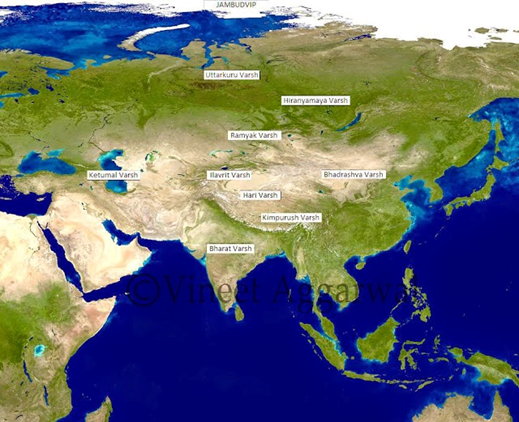
Another foolish theory attempts to ascribe the varshas of Jambudvipa to be the continents of the Earth itself such as found in the map below:
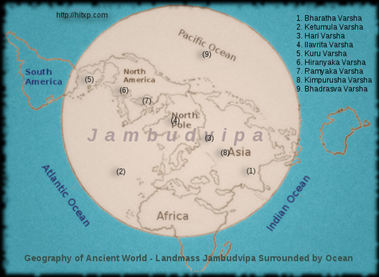
In the above map we see another complete misunderstanding of the Vedic universe wherein the cartographer completely disregards the description of varshas that cover hundreds of thousands of miles of territory, and wherein people are described as living idyllic heavenly conditions for thousands of years. Instead of presenting a map or image that depicts the actual description of Jambudvipa given in the Vedic texts, the cartographer instead simply identifies the varshas of Jambudvipa with the continents of our Earth. But the Srimad Bhagavatam's description of areas of the Earth covering hundreds of thousands of miles and territories with heavenly conditions, do not correspond in any way to America, Africa, and Europe, or indeed to any place in our known Earth.
So is the Srimad Bhagavatam's description of a greater Earth plane just mythology, or should the members of the International Society for Krishna Consciousness perhaps start developing some faith in the Vedic description of the Earth, and the history of the Pandava's pastimes upon it?
A question naturally arises that if King Yudhisthira ruled an area of the Earth which is measured at 800,000 miles, then where is the rest of this Earth kingdom? Are the Vedas presenting embellished legends regarding a great Earth circle, or is our current idea of an Earth globe simply a modern fantasy spun by scientists? We have argued in previous papers that the Earth globe idea is simply a product of different forces such as genuine ignorance, speculative science, and deliberate lies and manipulation which all combine to cover the true nature of the Earth. Ultimately it appears to be a delusion of maya that is now being dispersed by Srimad Bhagavatam's description of the true shape and extent of the Earth. According to Srimad Bhagavatam's description, the rest of the Earth is where it has always been, and surrounds our known Earth area in all directions. Of course, texts from ancient scriptures mean nothing to those opposed to, or completely disbelieving in the Vedic authority, but this should not be the case for any sincere follower of Vedic authority. For followers of Vedic authority it should be taken that Sukadeva Goswami is describing parts of the Earth that lay outside our measuring jurisdiction.
For those who may have obvious doubts in the idea of the greater Earth region described in the Srimad Bhagavatam and Mahabharata, I suggest undertaking a serious study of the hoax that NASA has pulled over the eyes of the world for the last 50 years in its presentation of the Earth as a globe rotating in space.
END OF PART TWO
Download article
Greater-Earth-Plane2.pdf
Greater-Earth-Plane2.doc
